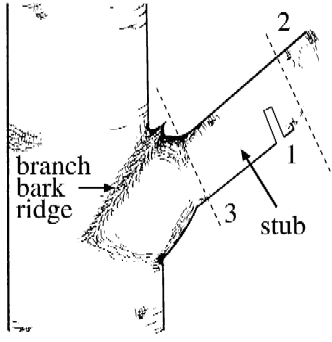How pruning is done
Where to trim?
There is a right way and a wrong way to remove branches. Do it right, and a healthy
scar will form. Otherwise, bacteria or fungus could get into the wound and cause rot to set in.
It is important to cut the branch and not the trunk, so that you don't remove any of the tissue the
tree needs in order to form a scar. Don't make the cut too high up, either, and leave a stub that
could allow parasites to infest the tree.
On what angle should you cut?
Here is where the science of tree trimming comes in.
 If you look carefully, you will see that where the branch meets the trunk there
is an elongated, wrinkled area, called the branch bark ridge. On birches, it is black and easy
to spot. Once you have found this ridge, proceed as follows:
If you look carefully, you will see that where the branch meets the trunk there
is an elongated, wrinkled area, called the branch bark ridge. On birches, it is black and easy
to spot. Once you have found this ridge, proceed as follows:
- make a small cut on the underside of the branch to be removed, to prevent
the bark from tearing when the branch falls;
- remove the branch above the cut;
- remove the stub, keeping the angle
of your cut equal but opposite to the angle formed by the branch bark ridge and the trunk;
- do not paint or cover the wound in any way.
Torn or wounded tree trunks or large branches
Trim around the wound or tear with a chisel to even out the surface. It is
also a good idea to go over the wound with sandpaper to reduce the risk of parasites infesting it.
|